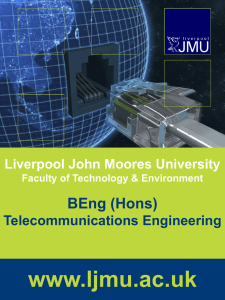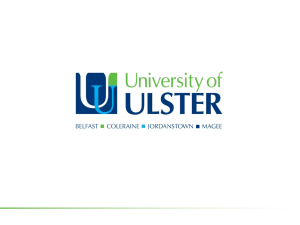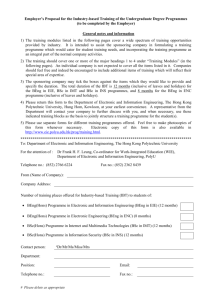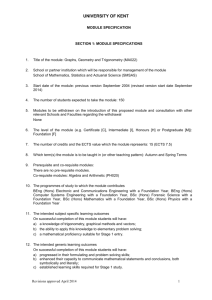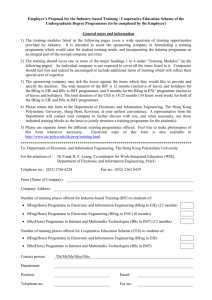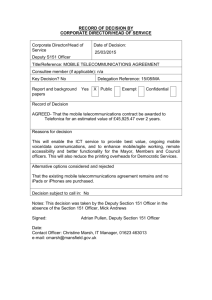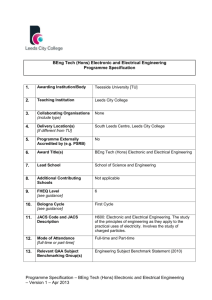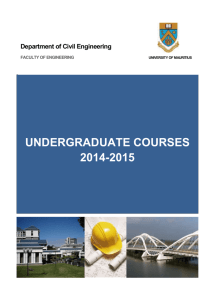Telecommunication Systems Engineering - BEng
advertisement
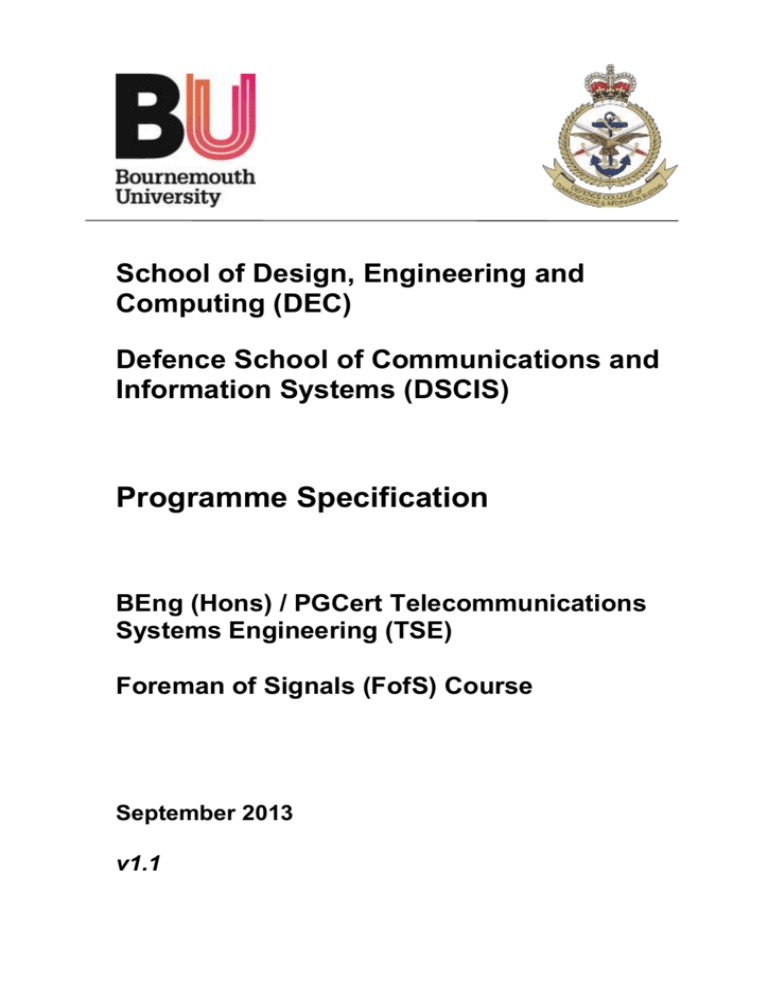
School of Design, Engineering and Computing (DEC) Defence School of Communications and Information Systems (DSCIS) Programme Specification BEng (Hons) / PGCert Telecommunications Systems Engineering (TSE) Foreman of Signals (FofS) Course September 2013 v1.1 BEng (Hons) / PGCert Telecommunications Systems Engineering © 2012 Bournemouth University Document date: June 2012 Circulation: General Bournemouth University undertakes to encourage the recognition, protection and exploitation of intellectual property rights generated by participants in this programme, to the benefit, as appropriate, of students, staff, industrial/other third parties/partners and the university. School of Design, Engineering & Computing Bournemouth University Poole Dorset BH12 5BB ii Programme Specification DCCIS June 2012 BEng (Hons) / PGCert Telecommunications Systems Engineering CONTENTS Abbreviations ..........................................................................................................................iv 1. Basic Programme Data.......................................................................................................1 2. Aims of the document .........................................................................................................3 3. Progression routes .............................................................................................................3 3.1 Recognition ..............................................................................................................3 3.2 Internal Progression.................................................................................................3 3.3 Additional Requirements – Distance Learning Package...........................................3 4. Academic and Professional Contexts, and Aims of the Programme ...................................4 4.1 Introduction ..............................................................................................................4 4.2 Aims of the Programme ...........................................................................................5 4.2.1 Course Outcomes ............................................................................................5 4.3 Course Structure......................................................................................................6 4.4 Benchmarks.............................................................................................................7 4.4.1 Engineering Benchmark ...................................................................................7 4.4.2 Computing Benchmarks ...................................................................................8 5. Intended Programme Outcomes – BEng (Hons) / PGCert Telecommunications Systems Engineering ........................................................................................................................10 5.1 Intended Level M / Programme Outcomes...............................................................10 5.2 Intended Level H / Programme Outcomes ...............................................................12 5.3 Intended Level I Outcomes ......................................................................................15 6. Programme Structure .........................................................................................................18 6.1 Overview..................................................................................................................18 6.2 Programme Diagram ...............................................................................................20 7. Admission Regulations .......................................................................................................21 7.1 Entry requirements ..................................................................................................21 7.2 Employment Experience ..........................................................................................21 7.3 Other Arms and Services .........................................................................................23 8. Assessment Regulations ....................................................................................................24 9. Points of Reference for Programme Design .......................................................................28 PROGRAMME PROFILE ........................................................................................................29 DCCIS June 2012 Programme Specification iii BEng (Hons) / PGCert Telecommunications Systems Engineering Abbreviations APCL Accreditation of Prior Certificated Learning APEL Accreditation of Prior Experiential Learning APL Accreditation of Prior Learning BSc CCNA Bachelor of Science Certificate level (Equivalent to year 1 of a traditional 3 year honours degree) Cisco Certified Network Associate CCNP Cisco Certified Network Professional CEng Chartered Engineer CIS Communication and Information Systems CPD Continuing Professional Development Cpl Corporal CS Communications Systems DCCIS Defence College of (CIS) DEC Design, Engineering and Computing (Bournemouth University) DipHE Diploma of Higher Education DLP Distance Learning Package ECTS European Credit Transfer and Accumulation System FdSc HNC Foundation Degree (Sciences) Framework for Higher Education Qualifications The framework for higher education qualifications in England, Wales and Northern Ireland, August 2008 Foreman of Signals Honours level (Equivalent to year 3 of a traditional 3 year honours degree) Higher National Certificate Hons Honours Hons ICT Honours Intermediate level (Equivalent to year 2 of a traditional 3 year honours degree) Information and Communications Technology IELTS International English Language Testing System IEng Incorporated Engineer IET Institution of Engineering and Technology ILO Intended Learning Outcome IS Information Systems IS Eng Information Systems Engineer C (level) FHEQ FofS H (level) I (level) iv Programme Specification DCCIS June 2012 BEng (Hons) / PGCert Telecommunications Systems Engineering ITIL Information Technology Infrastructure Library M (level) Master level (Equivalent to postgraduate degree study) MCM Div Manning and Career Management Division MOD Ministry of Defence N/A Not Applicable NVQ National Vocational Qualification OC Officer Commanding OGC Office of Government and Commerce OND Ordinary National Diploma PGCert Post Graduate Certificate QAA Quality Assurance Agency (for Higher Education) RSS Royal School of Signals SET Systems Engineering Technician Sgt Sergeant SNCO Senior Non-Commissioned Officer SOinC Signal Officer in Chief SSgt Staff Sergeant TSE Telecommunications Systems Engineering UETB Unit Employment Testing Board UK Standard for Professional Engineering Competence (June 2011) UK-SPEC DCCIS June 2012 Programme Specification v BEng (Hons) / PGCert Telecommunications Systems Engineering BEng (Hons) / PGCert TELECOMMUNICATIONS SYSTEMS ENGINEERING 1. Basic Programme Data Originating institution(s) Defence School of CIS (DSCIS) Award(s) and title(s) DipHE Telecommunications Systems Engineering BEng (Hons) Telecommunications Systems Engineering PGCert Telecommunications Systems Engineering Completion of this programme of study leads to military qualification: Foreman of Signals (FofS) UCAS Programme Code(s) N/A External reference points(s) The Engineering Council, 2010a. The Engineering Council: UK Standard for Professional Engineering Competence Engineering technician, Incorporated engineer and Chartered Engineer standard, 2010. The Engineering Council, 2010b. The Engineering Council: The Accreditation of Higher Education Programmes: UK Standard for Professional Engineering Competence. The Quality Assurance Agency for Higher Education, 2007. Subject Benchmark Statement: Computing 2007. The Quality Assurance Agency for Higher Education, 2008. The Framework for Higher Education Qualifications in England, Wales and Northern Ireland August 2008. The Quality Assurance Agency for Higher Education, 2010. Subject Benchmark Statement: Engineering 2010. Institution of Engineering and Technology, 2006. IET Handbook of Learning Outcomes for BEng and MEng Degree Programmes. Professional, Statutory and/or Regulatory Body links Institution of Engineering and Technology (IET). The IET already recognise the FofS degree under a Special Registration Agreement (July 2011). Place(s) of delivery Defence College of CIS (DCCIS) Mode(s) of delivery Full Time Credit structure Level I – 120 (60) Level H – 120 (60) Level M – 60 (30) DCCIS June 2012 Programme Specification 1 BEng (Hons) / PGCert Telecommunications Systems Engineering Duration 75 weeks over 20 months Date of original approval(s) Apr 2003 (as BSc) Date of first intake September 2012 Student numbers Minimum 5 / Maximum 20 / Optimum 14 Placements N/A Partner institution(s) and model(s) Defence School of CIS (DSCIS) Standard Collaborative Date and version number of this Framework/Programme Specification v1.1 September 2013 This Programme Specification was updated in October 2013 following changes to the University’s standard assessment regulations, updates to the progression arrangements from FdSc Communication Systems Engineering and the inclusion of the DSCIS Operational Statement. It takes effect from September 2013 and applies to all new enrolments only. * This programme replaces/was previously named BSc (Hons) Telecommunications Systems Engineering REGS 1314 02 To reflect recent changes to the University's standard assessment regulations, the following change has been recorded to the formal exceptions for the programme: The section titled Provision for failed candidates, reassessment, to reflect that a first attempt will be uncapped, a second attempt will be capped at the pass mark at formal element level and that a third and final attempt will be capped at the pass mark at unit level to ensure parity of academic outcomes with other programmes that follow BU standard assessment regulations as repetition of units is not allowed on this programme. There are no other changes to the previously approved exceptions. 2 Programme Specification DCCIS June 2012 BEng (Hons) / PGCert Telecommunications Systems Engineering 2. Aims of the document The aims of this document are to: Define the structure of the Telecommunications Systems Engineering (TSE) programme Identify programme and level learning outcomes Articulate the regulations governing the awards offered through this programme 3. Progression routes Only specially selected, experienced Class-1 SNCO Technicians are allowed entry to the course. These candidates are already qualified to HNC level. There are two routes by which students may gain admission to the course: 3.1 Recognition Legacy feeder course. Students who have successfully completed the Higher National Certificate (HNC) Telecommunications, awarded by Edexcel, will be eligible to apply for entry with advanced standing to the TSE programme and credited with 120 credits at Level C. 3.2 Internal Progression Future feeder course. Students who have successfully completed HNC in CS Engineering plus the 20 credit module Project Development (both gained through the FdSc in Communications Systems Engineering) will be eligible to apply for entry with advanced standing to the TSE programme and credited with 120 credits at Level C. 3.3 Additional Requirements – Distance Learning Package In addition to the above: students will have satisfactorily completed a Distance Learning Package (DLP) and passed qualifying entrance examinations before being accepted onto the Foreman of Signals course. Consequently, the engineering units start at Level I. DCCIS June 2012 Programme Specification 3 BEng (Hons) / PGCert Telecommunications Systems Engineering 4. Academic and Professional Contexts, and Aims of the Programme 4.1 Introduction The course is primarily a career course delivered by Defence College of CIS currently located in Blandford Camp. The military designation is Foreman of Signals (FofS) course. The course is delivered annually and has a long and distinguished history; it has been in existence since 1951. The main population of students are Sergeants (Sgts) and Staff Sergeants (SSgts) in the British Army: on arrival, these students will already have considerable work experience and on completion of the course, will assume the lead technical role in the Army. Over the years the course has evolved. Currently the course content maps well to a civilian qualification equivalent to a BEng (Hons) degree plus a PGCert. The civilian qualification is deemed to be of great value to the course; it assists with quality and provides tremendous motivation for the students who are encouraged to seek professional recognition and to maintain up-to-date knowledge through continuing professional development (CPD). However, the main focus of the course is to prepare students for their military employment. The course adopts a systematic and rigorously applied theoretical foundation to ensure students develop a well established knowledge base that they can apply to a wide range of applications. Consequently, the most important intellectual skill developed on the course is the flexibility to apply to a wide range of situations. Because of the highly vocational nature of the course and the requirement to provide solutions to unpredictable problems in unfamiliar situations, graduates must demonstrate a sound practical skill level throughout the course. The course offers a wide range of delivery modes to develop student theoretical knowledge, analytical, problem solving, practical and managerial skills in the field of telecommunications and information systems. The academic units, covered early in the course, enable the student to develop an understanding of telecommunications systems and to appreciate what impact these have on system performance and design. The schedule includes a good deal of practical activity. In addition, the theoretical concepts are fully supported with demonstrations and simulations. Indeed, much of the early work is heavily dependent on simulation to enable rapid coverage and enhancement of understanding of the wide range of theoretical concepts. Throughout the course, students are encouraged to challenge and argue rather than accept material presented to them. As experienced technicians this mode of behaviour should be relatively easy to adopt. 4 Programme Specification DCCIS June 2012 BEng (Hons) / PGCert Telecommunications Systems Engineering 4.2 Aims of the Programme The aim of the FofS course is to train and educate Class-1 Technicians to become SSgt (FofS) who are the Royal Corps of Signals' technical systems engineers and middle managers. The course could also be suitable for similarly qualified and experienced technicians from foreign defence forces. From an educational perspective the course is designed to develop the skills of an individual so that they can operate effectively in highly pressurised conflict situations, in setting up and maintaining vital communications. They will be expected to be able to analyse a wide variety of unpredictable communications problems and present to the Commander alternative solutions together with their implications and risks. This will require the honing of essential knowledge-based, intellectual and practical skills. 4.2.1 Course Outcomes Details of some of the job requirements for a FofS are given under the following headings: Supervise the deployment and maintenance of the Army's telecommunications systems. Solve non-routine, unpredictable technical problems and devise innovative system improvements and modifications. Analyse Technical problems and Advise on solutions. Research Information and provide Technical Assistance Analyse complex information and present findings. Evaluate communication systems and promote the effective passage of Information. Manage CIS Systems and Networks Evaluate potential electronic threats, in specific environments, in order to devise preventative measures to protect vulnerable CIS systems. Manage Projects Manage Equipment Procurement Responsible for on-the-job training of technicians Manage Personnel and Budgets The selected individual attending the FofS course is already a very experienced and highly commended Senior Non-Commissioned Officer (SNCO) technician; consequently not all aspects of the job requirements are covered fully on this course. DCCIS June 2012 Programme Specification 5 BEng (Hons) / PGCert Telecommunications Systems Engineering 4.3 Course Structure The course is divided into 5 15-week phases (terms) of study. Phases (1 and 2) build on the student's previous education and training to provide the foundation needed for the study of communications and information systems engineering and the academic knowledge needed to understand current and future telecommunications systems. The course begins with Intermediate ( I ) level units. Intermediate level units provide underpinning knowledge and ensure that all students are brought up to the same level since there are different feeder courses. Intermediate level units have a strong practical element with assignments and projects designed to simulate unpredictable problems the student will meet in future employment. Phases (3 and 4) consolidate the learning and provide contextualisation by applying the systems engineering principles developed in the earlier phases to specific military communications and information systems, with emphasis on technical management and maintainability. These specialised studies are then linked to group compulsory projects which are based on study and research carried out in the final phases, but also utilise knowledge and skills acquired throughout the course. The main phase of the course is at Higher ( H ) level and these units are closely related to military practice with very close theoretical support. This phase culminates in a 40-credit project that will investigate or resolve a problem concerning telecommunications or information systems. The students will be expected to use original thought to devise and evaluate alternative options and justify a preferred solution. Students will be required to undertake a real CIS oriented project that has been submitted by a MOD agency that requires a practical solution to a real engineering problem. Students will generally be required to work in syndicates but their individual contributions are clearly identifiable. The project brings together the subject material taught on the course and allows the students to demonstrate that they are able to apply the theoretical and practical skills learnt on the course. The learning objectives of the project are achieved largely as a result of analytical judgement, practical experience and the guidance of project supervisors. Blandford Camp is the home of a number of CIS agencies and is consequently a rich source of realistic projects, consultants, project supervisors and specialist equipment. However, many of the project proposals are submitted from a wide cross-section of the Field Army. Phase 5 concentrates on the more advanced technologies by examining how those advanced technologies may be brought into military service and how current systems may develop to make better use of new technologies and recent developments. The course is brought to an end with Master ( M ) level units. This final phase of the course brings the students up-to-date with a wide range of current communication technologies building upon their earlier studies. 6 Programme Specification DCCIS June 2012 BEng (Hons) / PGCert Telecommunications Systems Engineering 4.4 Benchmarks 4.4.1 Engineering Benchmark Ref: Engineering Council The Accreditation of Higher Education Programmes June 2011. For Incorporated Engineer (IEng) standard the Specific Learning Outcomes in Engineering that the programme covers, are set out in the following table, with their relationship to individual units. Benchmark Component Unit Title Underpinning Science and Mathematics ( I ) Engineering Science, ( I ) Digital Electronics and Computer Hardware, ( I ) Analogue Electronics in Communication Systems ( I ) Data Communications (CCNA) Engineering Analysis ( I ) Engineering Science, ( I ) Digital Electronics and Computer Hardware, ( I ) Analogue Electronics in Communication Systems ( I ) Data Communications (CCNA) ( H ) Network Security ( H ) Radio Communication Systems ( H ) Network Management Design ( I ) Information Technology Service Lifecycle ( H ) Network Security ( H ) Radio Communication Systems ( H ) Network Management ( H ) CIS Engineering Project Economic, Social and Environmental Context ( I ) Information Technology Service Lifecycle ( H ) Network Security ( H ) Radio Communication Systems ( H ) Network Management ( H ) Key Skills for Engineering Managers ( H ) CIS Engineering Project Engineering Practice ( H ) Information Technology Service Lifecycle ( H ) Network Security ( H ) Radio Communication Systems ( H ) Network Management ( M ) Computer Based Systems ( M ) Advanced Communications Systems ( M ) Advanced Routing DCCIS June 2012 Programme Specification 7 BEng (Hons) / PGCert Telecommunications Systems Engineering 4.4.2 Computing Benchmarks The following is a mapping of knowledge areas given in Annex B (Body of Knowledge) of the QAA Computing Benchmark 2007 document to the unit(s) in the programme that covers the same knowledge area. 8 Benchmark Component Unit Title Architecture ( I ) Digital Electronics and Computer Hardware, Artificial intelligence - Comparative programming languages ( I ) Digital Electronics and Computer Hardware, Compilers and syntax directed tools ( I ) Digital Electronics and Computer Hardware, Computational science ( I ) Digital Electronics and Computer Hardware, Computer based systems ( I ) Digital Electronics and Computer Hardware, Computer communications ( I ) Digital Electronics and Computer Hardware, ( I ) Data Communications (CCNA) ( H ) Network Security ( H ) Network Management Computer hardware engineering ( I ) Digital Electronics and Computer Hardware, ( H ) Network Security ( H ) Network Management Computer networks ( I ) Data Communications (CCNA) ( H ) Network Security ( H ) Network Management Computer vision and image processing ( M ) Advanced Digital Communications Concurrency and parallelism ( I ) Digital Electronics and Computer Hardware, ( M ) Software Based Systems Databases ( M ) Software Based Systems Data structures and algorithms ( M ) Software Based Systems Developing technologies ( M ) Software Based Systems Distributed Computer Systems ( M ) Software Based Systems Document Processing ( I ) Information Technology Information Library e-Business ( I ) Information Technology Information Library Empirical approaches - Games computing - Graphics and Sound ( I ) Analogue Electronics in Communication Systems Programme Specification DCCIS June 2012 BEng (Hons) / PGCert Telecommunications Systems Engineering Human-Computer Interaction (HCI) ( M ) Software Based Systems Information Retrieval ( I ) Information Technology Information Library Information Systems ( M ) Software Based Systems Intelligent Information Systems Technologies - Management issues ( I ) Information Technology Information Library ( M ) Software Based Systems Middleware ( M ) Software Based Systems Multimedia - Natural language computing - Operating systems ( M ) Software Based Systems Professionalism ( I ) Information Technology Service Lifecycle ( H ) Network Security ( H ) Key Skills for Engineering Managers Programming fundamentals ( I ) Digital Electronics and Computer Hardware Security and privacy ( I ) Information Technology Service Lifecycle ( H ) Network Security ( H ) Key Skills for Engineering Managers Simulation and Modelling ( I ) Engineering Science, ( I ) Digital Electronics and Computer Hardware, ( I ) Analogue Electronics in Communication Systems ( I ) Data Communications (CCNA) ( H ) Network Security ( H ) Radio Communication Systems ( H ) Network Management ( M ) Software Based Systems ( M ) Advanced Communications Systems ( M ) Advanced Routing Software engineering ( M ) Software Based Systems Systems analysis and design ( M ) Software Based Systems Theoretical computing - Web-based computing ( M ) Software Based Systems DCCIS June 2012 Programme Specification 9 BEng (Hons) / PGCert Telecommunications Systems Engineering 5. Intended Programme Outcomes – BEng (Hons) / PGCert Telecommunications Systems Engineering This programme provides opportunities for students to develop and demonstrate their knowledge and understanding, and various skills at Level M, Level H and Level I. Reference to the General learning outcomes (Engineering Council 2010). 5.1 Intended Level M / Programme Outcomes A – Subject Knowledge & Understanding A1 Emerging Technologies in Telecommunication Systems A2 Computer Systems Operation A3 Network Security & Network Management Techniques Learning and Teaching Methods and Strategies Acquisition of (A1 to A3) is through lectures on current equipment and developments taking place in communications engineering. Students are asked to undertake research into emerging technologies and investigate what is currently available in the Army and what is coming through in the future. Assessment Assessment of knowledge and understanding is through a combination of unseen written examinations and assessed coursework (A1 to A3) in the form of laboratory and coursework reports, and project reports & presentations (A1 to A3). All modules will involve a research component and students are assessed on the breadth of their research. B – Intellectual Skills B1 Critically evaluate the operational effectiveness of telecommunication systems B2 Critically analyse and interpret results B3 Identify and solve novel and unpredictable communications related problems Learning and Teaching Methods and Strategies Intellectual skills (B1 to B3) are developed through the research exercises set in the units. Students must be selective in the material they investigate and be able to deal with conflicting information. Lectures/tutorial help students to develop critical thinking by case studies. Assessment Skills (B1 to B3) are assessed mainly through the research assignments set. The terminal 10 Programme Specification DCCIS June 2012 BEng (Hons) / PGCert Telecommunications Systems Engineering examination also tests students’ ability to deal with conflicting information. C – Practical Skills C1 Plan and execute experiments to evaluate performance and behaviour C2 Investigate software based systems C3 Set-up and configure a data network Learning and Teaching Methods and Strategies Skill C1 may be developed by using simulations and by carrying out computer based experiments. Skill C2 may be developed by developing and using software to compare the performance of different products and different techniques. Skill C3 is developed by investigating more advanced configurations of data networks that would be required over much larger geographical areas. These skills can be practiced using simulations but can also be practiced using much larger scale networks that are available online – such equipment is remotely located but students can access the equipment over the Ethernet. Assessment Skill C1 is assessed by short exercises set by the instructor and student given time in front of the computer (or other equipment) using available software or resources students have developed themselves in a limited time window. Skill C2 is assessed by report or can be assessed by scenarios that test the students’ work to see how many tasks the solution can deal with. Skill C3 can be assessed by conventional skills based assignment with student being set tasks and recording how many of those tasks can be completed in the time available. D – Transferable Skills D1 Structure and use ideas to communicate effectively in writing and orally D2 Work effectively individually and in groups to deadlines D3 Learn independently, with a critical viewpoint, in familiar and unfamiliar situations Learning and Teaching Methods and Strategies Research exercises, both formative and summative, both individual and group, are used to develop students’ skills (D1 to D3) further. Assessment Coursework, based on research exercises, are assessed for both technical content and for clarity, completeness, depth of analysis and concision. In this way skills (D1 to D3) may be assessed. DCCIS June 2012 Programme Specification 11 BEng (Hons) / PGCert Telecommunications Systems Engineering 5.2 Intended Level H / Programme Outcomes A – Subject Knowledge & Understanding A1 Mathematics and Engineering Science relevant to Communications Engineering A2 Telecommunications Techniques A3 Computer Systems, Networks & Data Communications A4 Information Management Best Practice A5 Network security techniques A6 Military Deployable and Fixed Communications Techniques A7 Plan and control an operational deployment of military assets Learning and Teaching Methods and Strategies Throughout, the learner is encouraged to undertake independent study to consolidate and supplement their knowledge, and enhance and broaden their understanding of the course material covered. A1 to A4 appear throughout the level as required as specific equipment and systems require description of their construction and operation. There are supporting lectures at this level although there is a transition to practice on actual in-service equipment in realistic training scenarios. Depending upon the project selected students may be required to solve problems requiring deep understanding of specific equipment and systems. Acquisition of A5 is delivered using a range of lectures, tutorials and case studies. Students must understand the regulations and policy requirements for their chosen profession. Some of these require a change in attitude to understand why procedures must be followed closely. There is a need to reinforce why procedures must be adhered to and not simply tell the students the list of rules. Acquisition of A6 and A7 is delivered by briefings and then extensive exercises. These exercises are remarkably well resourced with equipment and personnel available for realistic exercise scenarios. Assessment Assessment of (A1 to A3) is assessed by the students’ ability to apply the underpinning theory in practical applications. Assessment of (A4 to A5) is through a combination of assignments and exercises. There are some fundamental policy rules which must be known and multiple choice tests may be used to assess depth and breadth of knowledge. Assessment of A6 and A7 is through a more complex pattern of observation of the students’ ability to cope with the work and by assessment of presentation skills. Throughout the exercises senior personnel will appear unannounced and ask to be briefed on current activities and status. 12 Programme Specification DCCIS June 2012 BEng (Hons) / PGCert Telecommunications Systems Engineering B – Intellectual Skills B1 Critically, apply analysis, design and development concepts B2 Critically analyse and interpret results B3 Critically evaluate the operational effectiveness of telecommunication systems B4 Identify and solve communications related problems B5 Design a fixed communications network and critically evaluate its management and security features B6 Identify and solve novel and unpredictable communications related problems Learning and Teaching Methods and Strategies Intellectual skills (B1 to B4) are further developed through all the units. During lectures/tutorial students are posed with problems and asked to consider possible difficulties, opportunities and alternate solutions. As part of the CIS engineering project selected students will be presented with a real engineering requirement from a military unit and need to use independent thinking to solve these immediate and real difficulties. Intellectual skills (B5 and B6) are taught mainly by practical realistic exercise. Students are briefed on equipment and resources available and recommended working practices. Student then are challenged to deliver a solution to a realistic communications engineering task over a long exercise taking into consideration timescales for transportation, limitation on available resources, health and safety of personnel, and limitations of technology. Assessment Skills (B1 to B4) may be assessed by examination and coursework. Skills B5 and B6 are assessed by observation of the students on exercise, assessment of presentations and reports in the form of debriefs. C – Practical Skills C1 Plan and execute experiments to evaluate performance and behaviour C2 Construct interfaces to enable communication between non-compatible equipment C3 Set-up and configure a data network C4 Plan and execute deployment of communications assets to ensure secure and survivable links C5 Manage an Operational Deployment of Military Trunk or Radio Relay Systems Learning and Teaching Methods and Strategies Skill C1 is developed further particularly in the CIS engineering project. Skill C2 is reinforced during the advanced practical exercises. DCCIS June 2012 Programme Specification 13 BEng (Hons) / PGCert Telecommunications Systems Engineering Skill C3 is reinforced specifically in the network security topic where students draw upon their experience at level I and extend their abilities to consider wider aspects of the network that make it secure and reliable. Depending upon the project chosen, aspects of C1 to C3 may be developed further to meet the specific challenges therein. Skills C4 and C5 are developed during the military phases of the units at level H. During these units students encounter practical problems associated with power management, spectrum availability, geographical terrain variations and must be able to manage the system overall. Assessment Skills (C1 to C3) are assessed by assignments and by ability in the laboratories. Depending upon the project chosen there may be large practical elements involved in which case assessment will be by solutions and results provided. Skills C4 and C5 are assessed mainly by observation. Due to the nature of the exercises undertaken it may not be possible to break off and halt the exercise. Instead students are helped along to keep the resources (equipment and personnel) in place. Students are assessed on their ability to provide their own solutions and thus student requiring little assistance are awarded higher grades. D – Transferable Skills D1 Structure and use ideas to communicate effectively in writing and orally D2 Work effectively individually and in groups to deadlines D3 Learn independently, with a critical viewpoint, in familiar and unfamiliar situations D4 Lead and manage groups of military personnel on exercise, operationally or in barrack situation D5 Provide technical and situation briefings to senior managers/operational commanders D6 Learn independently, with a critical viewpoint, in familiar and unfamiliar situations Learning and Teaching Methods and Strategies Skills D1 and D6 are developed through exercises and coursework. Project work provides an opportunity to plan a project, to communicate that project to sponsor, and, at the end of the project, to a military audience. The project needs to be planned and deadlines adhered to. At the same time project work must involve an aspect of independent study undertaken individually. All of the transferable skills (D1 to D6) are developed in the management and development of the final group project through feedback on written reports and critiques on project presentations. Assessment Skills (D1 to D3) are assessed mainly through the project work (reports and presentations). 14 Programme Specification DCCIS June 2012 BEng (Hons) / PGCert Telecommunications Systems Engineering Skills (D4 to D6) are assessed as part of the military phase during which time students are asked to undertake a range of different activities such as reports, presentations and man management tasks (giving orders and setting tasks for the whole group). 5.3 Intended Level I Outcomes A – Subject Knowledge & Understanding A1 Mathematics and Engineering Science relevant to Communications Engineering, A2 Telecommunications Techniques, A3 Computer Systems, Networks & Data Communications, A4 Information Management Best Practice, A5 Network security techniques Learning and Teaching Methods and Strategies Throughout, the learner is encouraged to undertake independent study to consolidate and supplement their knowledge, and enhance and broaden their understanding of the course material covered. Acquisition of A1 is through a combination of lectures and workshops using simulation software (such as Mathcad) and practical electronic & communication laboratory exercises to compare measured results with theoretical/mathematical predictions. Acquisition of A2 is through a combination of lectures, demonstrations and laboratory sessions. Acquisition of (A3 and A5) is through a combination of lectures, laboratory sessions, practical exercises and case studies. Computer and fixed networking concepts are firmly established. Acquisition of A4 is through a well structured industry programme with an accurately defined syllabus leading to an industry recognised qualification. The recommended delivery pattern is roughly 50 % of the time spent in student contact with 50 % of the time set aside for independent study. Assessment Assessment of knowledge and understanding is through a combination of unseen written examinations (A1 to A4) and assessed coursework (A1 to A4) in the form of laboratory and coursework reports. A3 and A4 have a large knowledge based content in accordance with the industry bodies – multiple choice test are used extensively in these components. B – Intellectual Skills B1 Critically, apply analysis, design and development concepts, B2 Critically analyse and interpret results, DCCIS June 2012 Programme Specification 15 BEng (Hons) / PGCert Telecommunications Systems Engineering B3 Critically evaluate the operational effectiveness of telecommunication systems, B4 Identify and solve communications related problems, B5 Design a fixed communications network and critically evaluate its management and security features, B6 Identify and solve novel and unpredictable communications related problems, Learning and Teaching Methods and Strategies Intellectual skills (B1 to B6) are developed through the learning and teaching approach outlined in A above. All units involve groups of 20 (max class size) or less (typically 2 or for practical tasks and various group assignments), with the opportunity for the learner to be actively involved in the key issues. Development of Intellectual skills B1 and B2 occurs during the learning of technical units in the programme. Students are given all the tools they need including mathematical simulation software and measuring instruments to determine if the telecommunication system, or component, is doing the job it is designed to do and if not, why not. This is enhanced through the supervision of small group teaching, where all students attend all sessions, throughout the course. As the student progresses through the course, there is a progressive shifting of responsibility for learning to the student, as the student is expected to devote more time to individual study and develop projects. Assessment Skills (B1 to B6) and particularly the analysis, problem solving and evaluation skills, are assessed through unseen written examinations, coursework assignments, laboratory reports, project reports and project presentations. C – Practical Skills C1 Plan and execute experiments to evaluate performance and behaviour, C2 Construct interfaces to enable communication between non-compatible equipment, C3 Set-up and configure a data network, Learning and Teaching Methods and Strategies Skill C1 is initially developed in a number of the earlier units with hands-on practical experience in laboratories and through using computer based simulations. Skill C2 is developed through project work in the units to construct from scratch a piece of equipment through to testing and evaluation. Skill C3 is covered in great detail using a range of simulation tools and skills based practical elements including many opportunities for fault finding. Assessment Skill C1 is assessed throughout the course programme during practical exercises in most of the units. 16 Programme Specification DCCIS June 2012 BEng (Hons) / PGCert Telecommunications Systems Engineering Skill C2 is assessed by the students’ ability to choose the appropriate design, to construct the artefact, test it and then document the results. This could be achieved through observation, report and also presentation of results. Skill C3 is assessed by set skills based assignment exercises testing the students’ ability to connect networks together physically, to configure devices correctly and then to adopt a thorough testing regime. Inevitably faults will occur and through rigorous and systematic testing routine the detection and rectification of those faults may be achieved. D – Transferable Skills D1 Structure and use ideas to communicate effectively in writing and orally, D2 Work effectively individually and in groups to deadlines, D3 Learn independently, with a critical viewpoint, in familiar and unfamiliar situations. Learning and Teaching Methods and Strategies Skill D1 is developed through feedback on written reports and critiques on project presentations. Skill D2 is developed by opportunities to work in the laboratory with others with the objective of designing, building and testing equipment and recording results. Students are encouraged to keep logbooks and records of their work. Skill D3 is developed by a range of fault finding exercises where equipment has been prepared with known faults and students are set the task of identifying the mot likely cause of the fault and trying to rectify it. Assessment Skill D1 is assessed through laboratory & project reports and project presentations. Skill D2 is assessed through observation in the laboratory and quality of record keeping. Skill D3 is assessed through skills based assignments which can record how many faults the students can find, how many faults the students can rectify and how long it takes. DCCIS June 2012 Programme Specification 17 BEng (Hons) / PGCert Telecommunications Systems Engineering 6. Programme Structure 6.1 Overview The programme is offered in full-time study mode only. All units are compulsory. There are no pathway options. Only specially selected, experienced Class-1 SNCO Technicians are allowed entry to the course. These candidates are already qualified to HNC level. There are two routes by which students may gain admission to the course: The legacy feeder course is an HNC (Higher National Certificate) Telecommunications awarded from Edexcel. The future feeder course is an FdSc awarded by Bournemouth University for which students may only have achieved an intermediate award of HNC. Legacy Feeder New Feeder Class 1 (CS Eng) April (2009) Class 1 (SET) Systems Engineering Technician HNC – Edexcel Traditional DLP Class 1 (CS Eng) Communication Systems Engineer HNC/FdSc CSE– Bmth Uni Common DLP Under Development Foreman of Signals Foreman of Signals (Information Systems) BSc MIS – Bmth Uni Figure 1 – Feeder courses Students will have satisfactorily completed a Distance Learning Package (DLP) and passed qualifying entrance examinations before being accepted onto the Foreman of Signals course. Consequently, the engineering units start at Level I. Credit weighting of the units is based upon 1 unit of credit being awarded for every 10 hours of study at that level. There are 5 units at level I with a total credit value of 120 credits; units are 20 credits with the exception of the Data Communications (CCNA) unit which is 40 credits. 18 Programme Specification DCCIS June 2012 BEng (Hons) / PGCert Telecommunications Systems Engineering There are 5 units at level H with a total credit value of 120 credits; units are 20 credits with the exception of the project which is 40 credits. There are 3 units at level M with a total credit value of 60 credits; units are 20 credits. Phase 1 / Term 1 Aug/Sep Phase 2 / Term 2 Dec/Jan Level I Phase 3 / Term 3 Apr/May Phase 4 / Term 4 Aug/Sep Phase 5 / Term 5 Dec/Jan Apr/May Intermediate Assessment Board Level H Assessment Board Level M Level I – subsequent course Figure 2 – Scheduling of Units The course is delivered over 75 weeks (5 × 15 week terms). The course begins with intermediate level. Intermediate level is completed over the first two terms. Students are introduced to the Key Skills for Engineering Managers module over these same two terms. At the end of this term there will be an opportunity to convene a formally constituted exam board to confirm progression and intermediate awards. At the beginning of term 3 students begin the higher level modules. At some time during this period students will undertake a military training phase when they will carry out the specific military exercises embedded within the taught units. These exercises rely upon significant resources (including personnel) being provided and the timing of this phase can vary depending upon other demands on the resources including operations. Students complete the taught higher level modules and begin the project in the middle of term 4. When the taught higher level modules are complete students begin the Master level modules. These are studied in parallel with the higher level project. By the end of term 5 all units are complete. The final exam board may consider the final results and may consider the Intermediate level from the subsequent course at the same time. There will, therefore, be an opportunity to formally recognise progression and interim award/credit confirmation at this intermediate stage of the subsequent course. DCCIS June 2012 Programme Specification 19 BEng (Hons) / PGCert Telecommunications Systems Engineering 6.2 Programme Diagram PROGRAMME DIAGRAM BEng (Hons) / PGCert Telecommunications Systems Engineering Programme Term 5 / Level M Core units (Compulsory) Exit qualification: BEng (Hons) Telecommunications Systems Engineering PGCert Telecommunications Systems Engineering Computer Based Systems (20) Advanced Communications (20) Advanced Routing (CCNP) (20) Requires 60 Level M credits, 120 Level H credits, 120 Level I credits and 120 Level C credits Term 3 and Term 4 / Level H Core units (Compulsory) Progression requirements Requires 80 Level H credits, 120 Level I credits and 120 Level C credits Radio Communication Systems (20) Network Security (20) Network Management (20) CIS Engineering Project (40) Key Skills for Engineering Managers (20) Exit qualification: BEng Telecommunications Systems Engineering Requires 80 Level H credits, 120 Level I credits and 120 Level C credits Term 1 and Term 2 / Level I Core units (Compulsory) Progression requirements Digital Electronics / Computer Hardware (20) Requires 120 credits at Level I Analogue Electronics in Communication Systems (20) Information Technology Service Lifecycle (20) Engineering Science (20) Data Communications (CCNA) (40) 20 Programme Specification Exit qualification: Dip HE Telecommunications Systems Engineering Requires 120 Level I credits and 120 Level C credits DCCIS June 2012 BEng (Hons) / PGCert Telecommunications Systems Engineering 7. Admission Regulations The regulations for this programme are the University's Standard Undergraduate Admission Regulations with the approved exceptions described in the sub-paragraphs below. Internal Progression: Students who have successfully completed the Defence School of Communications and Information Systems FdSc Communications Systems Engineering (CSE) will be eligible to apply for entry with advanced standing to Level I only of the BEng (Hons) Telecommunications Systems Engineering (TSE) Foreman of Signals (FofS) and credited with 120 Level C credits. Admission to the TSE programme follows the same selection procedure as for the FofS (IS) but for selection to be a FofS. Therefore as these awards are based on military career courses, in practice progression would only be after a period of military work experience, the satisfactory completion of a Distance Learning programme and a formal military selection process. Although the students would have 240 credits at Level I and theoretically eligible to progress to the H level units on an Hons programme BSc (Hons) Management of Information Systems (MIS), in practice students lack some of the Level I underpinning necessary for some of the higher units in the BEng(Hons) TSE, specifically in the areas of engineering mathematics and electronics. Therefore, students will be required to complete additional Level I credits which are already delivered as part of the BEng programme. The University’s Standard Postgraduate Admission Regulations apply for entry to Level M. 7.1 Entry requirements The aim of this course is to train and educate Class 1 Technicians to become SSgt (FofS) who are the Corps' technical systems engineering and middle managers. Hence entry to the course is a prolonged and highly selective process. Prospective candidates apply to their OC to join the FofS selection programme. Suitable candidates, who will already possess an HNC (OND prior to Sept 2002), will then be enrolled to undertake the distance learning course that starts in May of each year. The distance learning modules are partially revisionary, but also include study of new and more advanced material in preparation for the FofS course. Candidates who successfully pass the entrance examination may be invited to attend the FofS Selection Board. The selection board, which spans (3 to 4) days, assesses practical and potential managerial skills of those candidates considered to be academically suitable. Up to 18 successful candidates will be invited to attend a subsequent FofS Course. Students will be “mature” (i.e. around 25 years to 28 years of age) and will have had considerable previous employment experience. 7.2 Employment Experience Prospective candidates for the FofS course are specially selected from highly trained and very experienced Royal Signals Class-1 Sgt Technicians. They achieve this responsible position by following the career path listed below: After an initial 3 month Army familiarisation course, soldiers who were specially selected as DCCIS June 2012 Programme Specification 21 BEng (Hons) / PGCert Telecommunications Systems Engineering Royal Signals Technicians (on the basis of education or aptitude) attend a 42 week Class-3 technician course at RSS. Those who successfully complete the Class-3 technician course are posted to the Field Army as Class-3 technicians. They are all registered on the Advanced Modern Apprentice scheme and most will earn an NVQ Level-3 within a year of becoming a class-3 technician. When employed on operational field Army units, Class-3 technicians will receive more on the job training and supervision by experienced technicians. In particular their progress will be continuously monitored and assessed by the unit/department Foreman of Signals. When his/her progress is considered fitting and, after at least a year's experience, a Unit Employment Testing Board (UETB) is convened to assess reports and general progress. If found suitable, the candidate may be appointed to be a Class-2 technician by the UETB. After serving at least 2/3 years as a Class-2 technician (probably having been promoted to Cpl) a Class-2 technician may be invited (by MCM Div - posting branch) to take a Class 2-1 entrance exam. Distance Learning material is available, as are crammer courses for selected individuals. If a Class-2 technician passes the Class 2-1 entrance exam, he/she will generally be invited to attend the next available Class-1 technician course. Legacy Intake (before April 2009): Upon successful completion of a 52 week Class-1 Systems Engineering Technician (SET) course, a Class-1 technician will be posted back to an operational Field Army post (also awarded an Edexcel HNC – Higher National Certificate Telecommunications). Future Intake (from April 2009): Upon successful completion of a 52 week Class-1 Communication Systems Engineer (CS Eng) course, a Class-1 technician will be posted back to an operational Field Army post (also awarded and HNC and upon completion of a project will be eligible for a foundation degree). After attending various military command/management courses (in addition to Education for Promotion) and gaining at least 3 more years experience, the individual will be eligible for promotion to Sgt. After serving at least 1 year as a Sgt Technician an individual may be recommended to enrol on the FofS Distance Learning programme. Some years, more than 100 individuals are registered on this programme. Only 18 candidates per year are selected to attend the FofS course. Students have, at minimum, satisfied the requirements for a minimum of 120 Level C credits to be awarded by Accreditation of Prior Certificated Learning (APCL). Further, the course is mapped closely to industry standard qualifications and there are two qualifications that cover two of the ( I ) level units: Unit 230 Information Technology Information Library (ITIL) Service Lifecycle – Students having completed all 5 modules of the Intermediate ITIL course may apply for APCL for 20 credits. Unit 250 Cisco Certified Network Associate (CCNA) – Students having completed all 4 modules of the CCNA course may apply for APCL for 40 credits. Students are eligible to apply for APCL for the above units on an individual basis. 22 Programme Specification DCCIS June 2012 BEng (Hons) / PGCert Telecommunications Systems Engineering 7.3 Other Arms and Services The course could also be suitable for similarly qualified and experienced technicians from other arms and services. For entry to the course they must undergo the distance learning programme and pass the entrance examinations with an average of at least 60 % and, for overseas students, be fluent in English to IELTS level 6. Up to 2 students of this category may be accepted. DCCIS June 2012 Programme Specification 23 BEng (Hons) / PGCert Telecommunications Systems Engineering 8. Assessment Regulations BEng (Hons) / PGCert Telecommunications Systems Engineering (Foreman of BEng (Hons) / PGCert Telecommunications Systems Engineering (Foreman of Signals Course), DSCIS (Aug 2013) The regulations for this programme are the University’s Standard Undergraduate and Postgraduate Assessment Regulations with the following approved exceptions to reflect the Army’s requirements and non-standard programme structure: Period of Registration The maximum periods of registration are as follows*: BEng (Hons): 4 years / DipHE: 2 years / (*no Level C) Compensation Compensation does not apply to any units. Progression To proceed to Level M, students must achieve 80 Level H credits and must meet the University’s admissions requirements for postgraduate study. Students who are no longer sponsored by the military may be withdrawn from the programme at any stage and be awarded credit for successfully completed units. Awards The award of Certificate of Higher Education is not available. Provision for failed candidates BEng (Hons)/ DipHE Failure and reassessment A student who fails at the first attempt in unit(s) carrying a total of no more than 40 credits at Level I or 40 credits at Level H is normally permitted to be reassessed, on two occasions only. Where a first reassessment (‘second attempt’) has taken place, the formal element mark will not exceed 40%. Where a second reassessment (‘third attempt’) has taken place, the unit mark will not exceed 40%. Repetition of units Repetition of units is not allowed. Where a student fails more than 40 credits at Level I or Level H, or fails the maximum number of reassessments, the Assessment Board will withdraw the student from the programme. 24 Programme Specification DCCIS June 2012 BEng (Hons) / PGCert Telecommunications Systems Engineering PGCert Failure and reassessment A student who fails a unit to a total value of no more than 20 credits at the first attempt is normally permitted to be reassessed, on two occasions only. Where a first reassessment (‘second attempt’) has taken place, the element mark will not exceed 50%. Where a second reassessment (‘third attempt’) has taken place, the unit mark will not exceed 50%. Repetition of units Repetition of units is not allowed. Where a student fails more than 20 credits at Level M, or fails the maximum number of reassessments, the Assessment Board will withdraw the student from the programme. ICT FACULTY OPERATING STATEMENT Introduction. Management of all the DSCIS courses is governed by the Management Policies (MP) within the DSCIS Management System. For the courses that are accredited by Bournemouth University for degrees (listed below), then the Academic Regulations, Policies and Procedures (ARPP) of the University are applied. However, if there is any conflict between them then the DSCIS policies are followed although there is scope for agreed variation on a case by case basis. The following statement clarifies those areas where such differences occur and courses of action have been agreed, specifically reassessments and Assessment Boards. Reassessments. The military policies for reassessment (MPs 2.7.07 – 11(RSS) Sig Regt Phase 3 Failure Policy and 2.7.09 – 11(RSS) Sig Regt Supervisor Failure Policy) require students to be reassessed during the course. Because the courses do not follow the traditional academic year, it is infeasible to wait to have a formal Assessment Board to approve a reassessment. Therefore, any potential failures are reviewed by the Link Tutor and the Programme Leader. Students who are eligible for reassessment (i.e. are within the maximum limits for reassessment) may be offered a reassessment prior to the formal Assessment Board, provided that the External Examiner is informed and agrees to this course of action. When the reassessment actually takes place is agreed following discussion with the academic and military staffs and the student. All assessments (including all fails and any reassessments) will be subject to the normal processes of moderation by the External Examiner who reports to the Assessment Board where the marks are ratified. Assessment Boards. Due to the fast-track nature of the courses, the BEng/PG Cert TSE and FdSc CSE and FdSE CSM programmes have been exceptionally approved to undertake in-level reassessments prior to the formal meeting of an Assessment Board where it is not always practical to hold a Board at the end of each level of study to approve progression. Therefore, where this is not possible, more than one level of assessment will be considered by the Assessment Board and progression will be considered automatic unless reassessments are involved. In such cases progression will be through Chair's Action by the Programme Leader, Link Tutor and External Examiner. The operational exceptions to determine reassessments are detailed below (see ‘Assessment Boards and provision for failed candidates’). DCCIS June 2012 Programme Specification 25 BEng (Hons) / PGCert Telecommunications Systems Engineering Mitigating Circumstances. Mitigating circumstances arrangements are articulated in 6K Assessment Boards: Policy and Procedure and 6J – Mitigating Circumstances including Extensions: Policy and Procedure. In situations where mitigating circumstances need consideration, and a second/third assessment is required, students will not know at the time of the second/third sitting whether the request for consideration of their circumstances has been approved. They will therefore undertake the second/third sitting not knowing if the work will be marked as if for the first time or as a reassessment where the mark would be capped. The outcome would be relayed to the student at the same time as the results are published following the Assessment board. The students should be made aware of this situation at the start of their studies and reminded of this if the situation arises within the course of their studies. Courses Accredited by Bournemouth University as at 1 Aug 2013 University Title Degree Award FdSc CSE DSCIS Title Communications Systems Management FdSc CSM Yeoman of Signals YSMR Management of Information Systems BSc MIS Foreman of Signals (Information Systems) SIMR Telecommunications Systems Engineering BEng / PG Cert TSE Foreman of Signals FFMR Communications and Information Systems Management* MSc CISM CISM IEMR Communications Systems Engineering DSCIS Code CEUR Class 1 - Communications Systems Engineer *Apart from MSC CISM, all of the above programmes have formally approved exceptions to the University’s standard assessment regulations. These appear in the programme specification alongside this operational statement. Assessment Boards and provision for failed candidates Assessment Boards i. FdSc CSE and FdSE CSM For the CSE and CSM programmes, Preparatory Boards and Assessment Boards are normally held in July and September. Additional Boards may be scheduled mid-year. Prior to these, separate Circumstance Boards are held, normally at the University. ii. BEng/PG Cert TSE programme For the BEng TSE programme, Preparatory and Assessment Boards should be held as soon as possible after the completion of the final unit for the level or for the stage of the programme under consideration, and within one month of the start of the following set of units. 26 Programme Specification DCCIS June 2012 BEng (Hons) / PGCert Telecommunications Systems Engineering Assessment Board Timing Consideration At the end of Level I Progression to Level H At the 80 credit Level H point Award of Non-Honours or Proceed to remainder of Level H and M Level units. This decision should include a discussion as to whether the whole profile of the student justifies admission to the PG section of the programme according to the standard PG admission regulations At the end of Level H and M (completion of programme) Award of Honours and PG Cert Provision for failed candidates Where students take reassessments, these should be scheduled as soon as is reasonably possible in order to prevent any accumulation of higher level credits before Level C has been successfully completed. The marks are sent to the Programme Administrator in DEC, along with the original 'sit' marks, and are calculated and shown on the spreadsheet, so it is evident which is the original mark and which is the resit mark. Any potential failures must be reviewed by the Link Tutor and students who are eligible for in-level reassessment (i.e. are within the maximum limits for reassessment) may be offered a reassessment prior to the Assessment Board provided that the External examiner is informed and agrees to this course of action. All assessments (including all fails and any reassessments) will be subject to the normal processes of moderation by the External Examiner who reports to the Assessment Board. Marks of first and second attempts are therefore not ratified until the Assessment Board who will also consider any recommendations in relation to mitigation. NB Marking, independent marking and moderation take place in line with Bournemouth University’s 6D - Marking, Independent Marking and Moderation: Policy and Procedure, including reassessments (2nd and 3rd attempts). DCCIS June 2012 Programme Specification 27 BEng (Hons) / PGCert Telecommunications Systems Engineering 9. Points of Reference for Programme Design Institution of Engineering and Technology, 2006. IET Handbook of Learning Outcomes for BEng and MEng Degree Programmes. IET Learning Outcomes 3.5.doc, 03/10/2006. Available from: http://www.theiet.org/ [Accessed 6 December 2011] The Engineering Council, 2010a. The Engineering Council: UK Standard for Professional Engineering Competence Engineering technician, Incorporated engineer and Chartered Engineer standard, 2010. ISBN-13 978 1 898126 67 6 Available from: http://www.engc.org.uk/ecukdocuments/internet/document%20library/UK-SPEC.pdf [Accessed 6 December 2011] The Engineering Council, 2010b. The Engineering Council: The Accreditation of Higher Education Programmes: UK Standard for Professional Engineering Competence. ISBN-13 978 1 898126 68 3. Available from: http://www.engc.org.uk/ecukdocuments/internet/document%20library/AHEP%20Brochure.pdf [Accessed 6 December 2011] The Quality Assurance Agency for Higher Education, 2007. Subject Benchmark Statement: Computing 2007. ISBN-13 978 1 84482 678 0. Available from: http://www.qaa.ac.uk/Publications/InformationAndGuidance/Documents/computing07.pdf [Accessed 6 December 2011] The Quality Assurance Agency for Higher Education, 2008. The Framework for Higher Education Qualifications in England, Wales and Northern Ireland August 2008. ISBN-13 978 1 84482 871 5. Available from: http://www.qaa.ac.uk/Publications/InformationAndGuidance/Documents/FHEQ08.pdf [Accessed 6 December 2011] The Quality Assurance Agency for Higher Education, 2010. Subject Benchmark Statement: Engineering 2010. ISBN-13 978 1 84979 224 0. Available from: http://www.qaa.ac.uk/Publications/InformationAndGuidance/Documents/Engineering10.pdf [Accessed 6 December 2011] 28 Programme Specification DCCIS June 2012 BEng (Hons) / PGCert Telecommunications Systems Engineering PROGRAMME PROFILE Originating Institution(s): Place(s) of Delivery: DCCIS Mode(s) of study 1: FT Framework Title (in full): BEng (Hons) / PGCert Telecommunications Systems Engineering Expected Length of study 2: 20 months Programme Award and Title: BEng (Hons) / PGCert Telecommunications Systems Engineering School: DEC Programme HESA JACS code: Partner institution: DCCIS BU Credit Structure & ECTS 3: Level M 60 (30 ECTS), Level H 120 (60 ECTS), Level I 120 (60 ECTS) Interim Award and Titles & required credits: DipHE Telecommunications Systems Engineering Cost Centre(s) 4 Assessment Regs 7: ASR Unit Details Unit identification Unit version no. Unit name GEN1119I-1 GEN1120I-1 GEN1121I-1 GEN1122I-1 EEE1122I-1 EEE1036H-1 CSE1111H-1 CSE1112H-1 EEE1013H-3 EEE1036H-1 NEW v1 NEW v1 NEW v1 HESA JACS Subject Code CC 1 Digital Electronics and Computer Hardware H610 119 Analogue Electronics in Communications Systems H610 119 Information Technology Service Lifecycle I111 121 Engineering Science H100 119 Data Communications (CCNA) I120 121 Radio Communication Systems I120 121 Network Security I120 121 Network Management I120 121 CIS Engineering Project I100 121 Key Skills for Engineering Managers I120 121 Computer Based Systems G5 39 Advanced Communications H6 20 Advanced Routing (CCNP) H1 16 10 Contact in School: Effective from Andrew Main (65501)/ Michael Jones (65062) Prog Year / Month / Year Yr. 1 Sept 2013 Yr. 2 Yr. 3 Sept Sept 2014 2015 % HESA JACS Subject Code CC2 100 100 100 100 100 100 100 100 100 100 100 100 100 Date approved 11: October 2013 Name of Professional, Statutory or Regulatory Body (if appropriate) 14: Institution of Engineering and Technology (IET) – Accreditation to be sought % Prog year 5 FT Prog year 5 PT Core / option No of Level credits (C,I,H, 6 PgC, PgD, M) 1 C 20 1 C 20 1 C 20 1 C 20 1 C 40 2 C 20 2 C 20 2 C 20 2 C 40 2 C 20 3 C 20 3 C 20 3 C 20 Programme Specification version no. 12: v1.1 I I I I I H H H H H M M M Assessment 8 Element Weightings Exam 1 60 % 60 % 50 % 60 % 60 % 60 % 60 % 60 % 60 % C/Work 1 40 % 40 % 50 % 40 % 40 % 100 % 40 % 100 % 100 % 100 % 40 % 40 % 40 % Placement 13: N/A Diploma Supplement Statement regarding PRSB accreditation 15 : Yr.4 DCCIS June 2012 Programme Specification 29 9 C/Work 2
